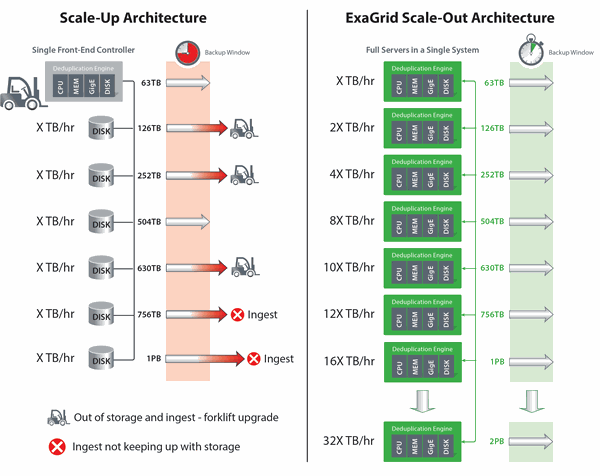Product Architectur
Why ExaGrid Hyperconverged Backup is intelligent
ExaGrid knows that deduplication is required, but how you implement it changes everything in the backup. Data deduplication reduces storage requirements and bandwidth for replication. However, if it is not implemented correctly, backups, restores and VM starts will be slowed down drastically and the backup window will get bigger with increasing amounts of data. This is due to the fact that data deduplication is very computationally intensive. You do not want to perform deduplication during the backup window, nor do you want to restore deduplicated data or boot from a pool.
Adaptive deduplication
Fastest backup / shortest backup window

Fastest restores, restores, VM starts and tape copies

Scalability: fixed length backup window and data growth

The Buyer's Guide to Storage for Backup
Supported backup applications
ExaGrid supports a variety of backup applications, utilities, and database dumps. In addition, ExaGrid enables multiple approaches in the same environment. An organization can use a backup application for their physical servers, another backup application or utility for their virtual environment, and can also perform direct Microsoft SQL or Oracle RMAN database dumps - all on the same ExaGrid system. This approach enables customers to use the backup application and utilities of their choice, to use the best backup applications and utilities, and to select the right backup application and utility for each use case.
If you change backup applications in the future, the ExaGrid system will continue to work and protect your original investment.
ExaGrid supports many unique functions and interfaces, such as These include improved performance for Veritas Backup Exec GRT, AIR for Veritas NetBackup, OST for Veritas Backup Exec, and Veritas NetBackup, the integrated Veeam Data Mover for Veeam, Veeam SOBR support, Oracle RMAN Channels support, and many more.
Many backup applications perform software-based data deduplication. ExaGrid deduplication leverages backup software and adds additional deduplication to increase overall ratios, resulting in additional disk and bandwidth savings.
ExaGrid is the only solution that offers a unique landing zone that stores full copies of the latest backups of all backup applications, utilities, and direct database dumps, making restores, restores, and tape copies as fast as reading from disk.Acronis Backup & Recovery
The ExaGrid system supports cost-effective and scalable disk-based backups with the Acronis® Backup & Recovery backup software. ExaGrid also supports the ability to replicate your Acronis Backup & Recovery backups to a second location to ensure disaster recovery protection outside the site.
Arcserve Backup, D2D, UDP
ExaGrid Systems is an Arcserve technology partner and offers Arcserve customers an extremely affordable alternative to tape backup.BridgeHead Healthcare Data Management
Carbonite Amanda
Commvault
ExaGrid improves the storage economy of Commvault environments. ExaGrid works with Commvault deduplication to reduce storage consumption by 20: 1 (3 times more memory than Commvault deduplication) and significantly improve recovery performance and solve scaling problems.
Dell EMC NetWorker
The ExaGrid system supports cost-effective and scalable disk-based backups with Dell EMC's NetWorker backup software. ExaGrid is an ISV program partner of Dell EMC Velocity Technology.
HYCU
HYCU is the only application and data protection solution specially developed for Nutanix. It not only preserves the simplicity of HCIS through native integration and a hypervisor-independent architecture with AHV, but also ensures an absolutely reliable backup and restore. Nutanix customers using HYCU can create faster and more reliable backups with ExaGrid's high-performance, scalable, disk-based backup appliance, while integrating quickly and easily into their Nutanix infrastructure.
IBM i / LaserVault
By backing up to an ExaGrid appliance through LaserVault, IBM iSeries customers can achieve improved backup performance, fast and reliable data recovery, and fast recovery from system or site failures.
IBM Spectrum Protect
When IBM Spectrum Protect customers install ExaGrid, management becomes much easier. Spectrum Protect and ExaGrid customers can back up their data quickly and efficiently with lower acquisition costs and lower costs over time. ExaGrid is three times faster for backups and up to 20 times faster for restores than any other deduplication appliance solution.
Idera SQL Safe
The ExaGrid system complements the security features of Idera ™ SQL Safe ™ and offers improved data protection management, fast and reliable online data recovery, improved security and fast data recovery after system or site disasters.
Micro Focus Data Protector
The ExaGrid system supports cost-effective and scalable disk-based backups with the backup software Micro Focus Data Protector. ExaGrid also supports replication of Micro Focus Data Protector backups to a second location to protect against disaster recovery outside of the location.
Microsoft SQL Dumps
ExaGrid Systems is a member of the Microsoft Partner Program and works with Microsoft to ensure the compatibility of Microsoft SQL Server and ExaGrid.
Oracle Recovery Manager (RMAN)
Oracle Recovery Manager (RMAN), a command line and Enterprise Manager based tool, is a common way to efficiently back up and restore Oracle databases. Customers can easily send Oracle backups directly to a disk-based ExaGrid backup system using the RMAN utility without using a backup agent.
Quest LiteSpeed
ExaGrid complements the backup features of Quest LiteSpeed and offers improved data protection management, fast and reliable online data recovery, improved security and fast data recovery after system or site disasters.
Quest NetVault
The ExaGrid system complements Quest ™ NetVault ™ SmartDisk and enables Quest NetVault ™ Backup, a comprehensive backup and recovery software solution that protects data and applications in various IT environments from an intuitive console. Multiple platforms are supported, including Windows, SQL Server, Oracle, UNIX, Linux, Mac, and VMware.
Quest vRanger
ExaGrid offers VMware customers using Quest vRanger the fastest backup and restore in the industry, as well as tremendously high data deduplication rates (up to many thousands to one).
Red Gate SQL Backup Pro
The ExaGrid system complements the backup capabilities of RedGate® SQL Backup Pro and offers improved data protection management, fast and reliable online data recovery, improved security and fast data recovery after system or site disasters.
StorageCraft ShadowProtect
With StorageCraft ShadowProtect software, ExaGrid offers reliable, affordable, and scalable disk-based backups for physical and virtual environments.
UNIX / LINUX File System Data Dumps
ExaGrid customers can easily transfer file system data from Unix or Linux systems to the ExaGrid server, avoiding the use of a backup agent.
Veeam Backup & Replication
VMware customers using industry-leading Veeam backup software can create faster, more reliable backups with ExaGrid's high-performance, scalable, disk-based backup appliance, while integrating quickly and easily into their existing infrastructure.
Veritas Backup Exec
ExaGrid was the first hard drive backup appliance provider to achieve the highest level of Veritas qualification for simple and optimized duplication (replication) with Backup Exec through the OpenStorage Technology (OST) program.
Veritas NetBackup
ExaGrid's support for NetBackup OST enables both onsite and offsite backup data stored on the ExaGrid system to be managed through the NetBackup console. The backup catalog is also kept up to date for replicated offsite backups. ExaGrid is designed to support the Optimized Duplication, A.I.R. and Accelerator OpenStorage Technology (OST) certified.
Veritas NetBackup Accelerator
ExaGrid is the only backup storage solution on the market that automatically resynthesizes NetBackup Accelerator backups and provides a full copy that can be restored 20 times faster than any other solution, including Veritas appliances.
Veritas System Recovery
With Veritas System Recovery, superior backup and disaster recovery capabilities for desktops and laptops can take advantage of ExaGrid compression and data deduplication at the byte level to save costs over standard disk solutions.
Zerto Offsite Backup
The ExaGrid system provides Zerto customers with Zerto Offsite Backup plus deduplication and thus cost-effective long-term storage for offsite backups of VMs that have been replicated from the primary site to the DR site.
References from Switzerland are available on request!
use cases

Physical environments
Up to 32 devices can be combined and adjusted in a single scale-out system.
An ExaGrid system can be scaled to 2 PB in a single system.
ExaGrid can protect up to 16 data centers in a hub-and-spoke topology with cross-site replication

Virtual environments
ExaGrid's unique approach enables all virtualized backup functions to be performed quickly, as ExaGrid maintains a full copy of the latest full VM backups in their complete, unduplicated form in an integrated landing zone, eliminating the need for time-consuming data rehydration for each request.

Distributed data center locations
All systems are managed regardless of their location via a single user interface with Internet Explorer, Chrome or Firefox.

Private cloud disaster recovery
ExaGrid supports up to 16 large data centers in a cross protection group with a master hub and 15 locations.
Over 50% of ExaGrid customers removed the tape both on-site and off-site using an on-site ExaGrid system for local backups and restores, and then replicated to an ExaGrid in a second location as a second data center for disaster recovery.

Hybrid cloud disaster recovery

Public cloud disaster recovery
A virtual ExaGrid that runs in AWS on an EC2 instance takes the replicated data and stores it in S3 or S3 IA.
The primary physical ExaGrid site replicates only deduplicated data for WAN efficiency to the virtual ExaGrid in AWS.



















